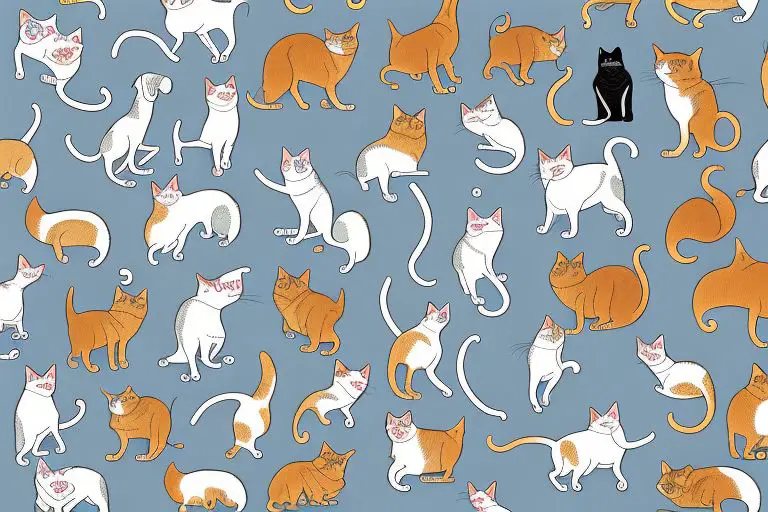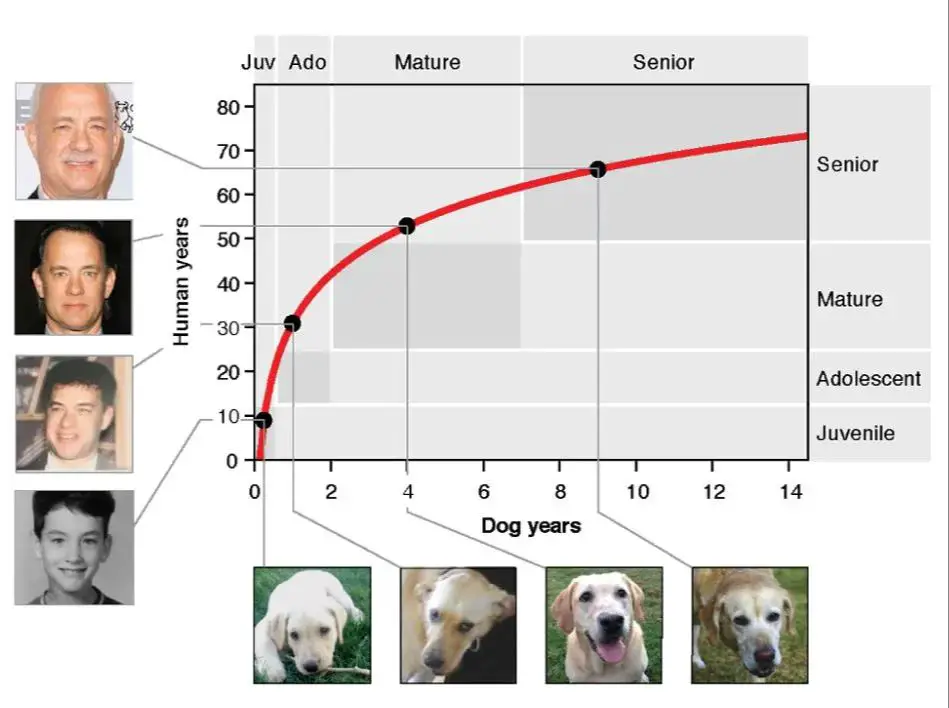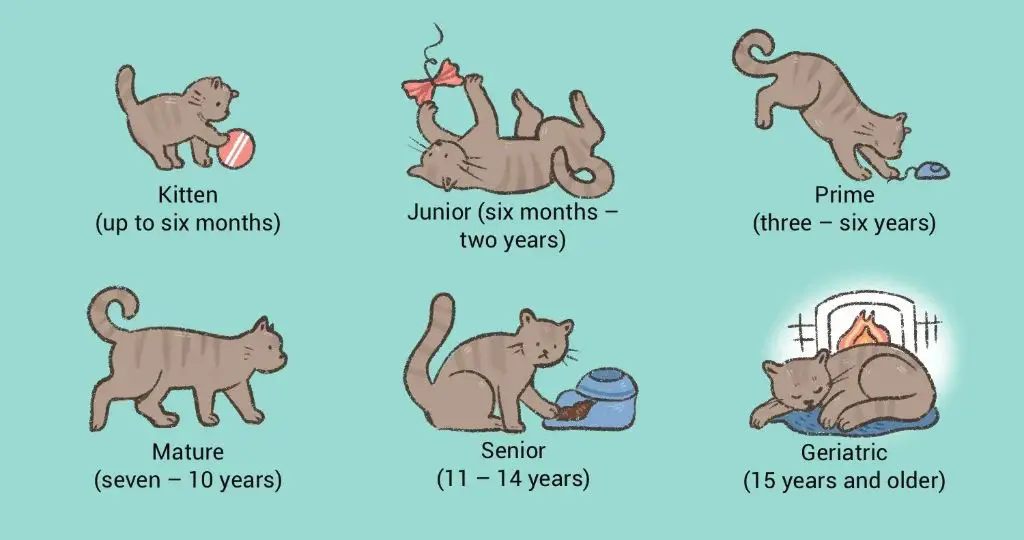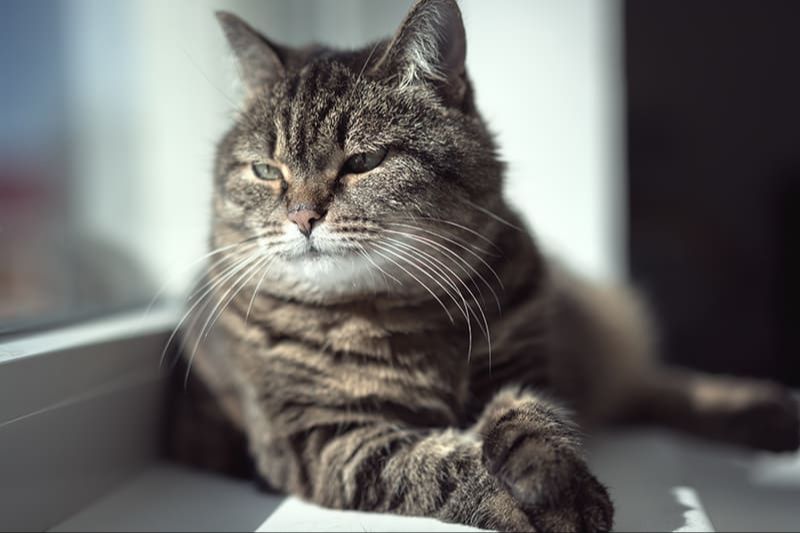
Many pet owners wonder if cat years are calculated the same as dog years. The old adage states that 1 year for a dog equals 7 years for a human. However, there is no definitive formula that converts cat years to human years in the same manner. This leads to confusion over how to compare feline and canine aging. Understanding the factors that influence lifespan and signs of aging in cats and dogs can provide insight into this puzzle of pet years versus human years.
How cats and dogs age
Cats and dogs age at different rates due to differences in their biology and life expectancy. According to the ASPCA, the average lifespan of a dog is 10-13 years, while the average lifespan of a domestic cat is 12-18 years (1).
Dogs physically mature faster than cats in the first 2 years of life. A 1-year-old dog is physiologically similar to a 15-year-old human, while a 1-year-old cat is comparable to a 6-7-year-old child (2). Dogs reach adulthood around 1-2 years old, while cats are not considered adults until around 2 years of age.
As pets get older, common signs of aging include: decreased activity levels, impaired hearing/vision, altered sleeping patterns, dental issues, changes in coat and skin condition, cognitive decline, and onset of chronic diseases like arthritis, kidney disease, and cancer (3). Cats tend to exhibit age-related changes later in life compared to dogs.
The different aging patterns are influenced by variables like breed, genetics, diet, lifestyle, and veterinary care. Larger dog breeds age more quickly than smaller breeds. Overall, cats and small dog breeds live longer than large dogs.
(1) https://www.aspca.org/pet-care/cat-care/general-cat-care
(2) https://www.petsplusus.com/pet-information/health/age-calculator
(3) https://www.thedoorbuddy.com/blogs/door-buddy/are-cat-years-the-same-as-dog-years
The 7 dog years to 1 human year ratio
The popular belief that 1 human year equals 7 dog years has been around for decades, but its origins are unclear. Some sources attribute it to French naturalist Buffon in the 1700s, who noted that dogs reached adulthood around age 2 and lived for 8-10 years on average. Since humans matured around 14-15 years old and lived to 70-80 typically, he proposed a 1:7 ratio.
The simple formula likely caught on because it provided an easy way for people to calculate their dog’s “equivalent” human age. It was a rule of thumb for approximating developmental stages too, suggesting a 1-year-old dog had the maturity of a 7-year-old child while a 4-year-old dog was similar to a 28-year-old adult.
While the 1:7 ratio isn’t very scientifically accurate, its persistence speaks to how strongly dog owners feel that their pets age faster than humans and want a way to relate their lifespans. The ratio gives people a sense that although their beloved dog’s life is short, they live just as full a life as we do.

Is there a similar ratio for cats?
While there is a commonly accepted ratio that 1 human year equals 7 dog years, there is no universally accepted ratio for converting cat years to human years. However, there are some general guidelines.
According to Pumpkin, the first year of a cat’s life is equal to about 15 human years. The second cat year equals about 9 human years. After that, each additional cat year is equal to about 4 human years.
Some vets use a rough calculation that the first 2 years of a cat’s life count as 25 human years. After that, each additional cat year counts as 4 human years. So by these calculations, a 5 year old cat would be approximately 41 in human years.
The difficulty with establishing a conversion ratio for cats is that cats age very differently in their first 2 years compared to later in life. Kittens reach maturity around 1-2 years, while aging slows down considerably after that. There are many factors that affect lifespan and aging in cats.
While simple ratios may provide rough estimates, it’s important to evaluate a cat’s health and development on an individual basis. There is no universally accepted formula for precisely calculating cat years to human years.
Factors that influence feline aging
While there is no simple formula to calculate cat years like there is for dogs, various factors can influence how quickly cats age. According to veterinarians, the two biggest factors are breed and environment.
Certain cat breeds tend to live longer than others. For example, Siamese and Persian cats often live into their mid-late teens, while Maine Coons and Ragdolls frequently reach ages 17-20. In contrast, Munchkin and Sphinx cats have much shorter average lifespans of 8-10 years. Genetics play a key role in determining longevity between breeds.
Living environment also significantly impacts lifespan. Indoor cats generally live longer as they face fewer external threats like cars, predators, diseases, etc. Providing enrichment through toys, cat trees, and activities also promotes wellbeing. According to this source, lower stress levels can slow cellular aging.

Gender is another influencing factor. Female cats tend to outlive males by 1-2 years on average. Experts believe hormones like estrogen provide health benefits for spayed females.
Pet Lifespans
When it comes to the average lifespan of cats versus dogs, there are some key differences. According to 1800petmeds.com [1], the average lifespan for dogs is 10-12 years, while the average lifespan for cats is 10-14 years. Cats generally live longer than dogs – on average, indoor cats live 15-20 years, while outdoor cats average 10-14 years. Small dog breeds tend to live longer, with an average lifespan of 15 years or more. Large dog breeds have a shorter lifespan, averaging 8-10 years. In general, cats outlive dogs by an average of 3-4 years.
There are several factors that contribute to cats often having longer lifespans than dogs. Cats tend to have fewer genetic disorders and diseases. They are also less susceptible to cancer. Cats are more agile and better able to avoid accidents and injuries. Additionally, cats typically experience a slower decline in health as they age compared to dogs. With proper nutrition, exercise, mental stimulation and veterinary care, pet owners can maximize their cat’s longevity.
Veterinary perspectives
According to Dr. Andrea Y. Tu, DVM and founder of Behavior Vets NYC, there are distinct differences between cats and dogs when it comes to aging (https://www.papayapet.com/resources/how-old-is-my-dog-or-cat-in-human-years/). While the popular 1:7 ratio of dog to human years provides a rough estimate, it oversimplifies the aging process. Dogs generally age faster during the first 2 years of life compared to humans. However, this ratio changes as dogs grow older. Smaller dog breeds tend to live longer than larger breeds. Genetics, diet, exercise, and general health all impact lifespan as well.
Cats age differently than dogs. During the first 2 years, cats mature rapidly. But after that, cats age more slowly in comparison to dogs. Indoor cats may live 16-18 years on average, while outdoor cats average 2-5 years. According to Dr. Tu, there is no set formula to calculate cat age in human years. The age-to-human-years ratio changes as cats get older. Once cats reach maturity around 2 years old, each additional year is approximately equivalent to 4 human years.
Signs of aging
As cats and dogs grow older, there are certain physical and behavioral changes that signal the aging process. Some common signs of aging in cats include decreased activity levels, increased sleeping, less interest in play, and appetite changes. Cats may begin losing muscle mass and develop arthritis, dental issues, or visual/hearing impairment. You may also notice more shedding, thin fur, greying hairs, weight loss or gain, altered vocalization, and cognitive changes like disorientation or forgetfulness.
In dogs, greying fur, cloudy eyes, weight gain or loss, dental problems, arthritis, lumps/bumps, and changes in sleeping patterns are telltale signs of aging. Dogs also tend to interact less, have difficulty with stairs/jumping, increased panting, and experience cognitive dysfunction. Common age-related diseases like cancer, kidney disease, and heart disease may emerge. Both cats and dogs display less energy, more frequent accidents, altered behavior, and greater need for medical care as seniors.
Caring for senior pets
Senior pets have different needs than younger pets. Here are some tips for keeping aging pets healthy and comfortable:
Ensure they have comfortable and accessible beds. Softer beds without sides can make it easier for older pets to get up. Place beds in easily accessible areas.
Make sure food and water bowls are close by and easy to access. Elevated bowls may be helpful for pets with arthritis.
Provide senior pets with nutritious food formulated for aging pets to support joint health and kidney function. Consult your veterinarian for recommendations.
Keep living areas easy to navigate with good lighting and non-slip surfaces. Remove tripping hazards.
Brush and groom senior pets frequently to prevent matted fur and keep their coat and skin healthy.
Make litter boxes low sided and highly accessible for elderly cats.
Keep senior pets at a healthy weight to reduce strain on their joints. Adjust food portions and exercise as needed.
Give pets joint supplements if recommended by your veterinarian to support mobility.
Adjust exercise routines to your pet’s abilities. Low impact exercise like short walks can help maintain joint health.
Schedule more frequent veterinary checkups to monitor your pet’s health and wellbeing as they age.
Be attentive to signs of pain or changed behaviors that could indicate health issues requiring veterinary attention.

With some adjustments and good care, senior pets can continue to lead happy and fulfilling lives well into their golden years!
Conclusion
In summary, while there is a common myth that 1 human year equals 7 dog years, this is an oversimplification. There is no equivalent simple formula for calculating cat years. A dog’s aging is influenced by its size and breed, with larger dogs tending to age more quickly. On average, veterinarians suggest a 1:5 or 1:6 ratio for the first 2 years of a dog’s life. After that, each human year equates to 4 dog years. For cats, aging slows after the second year, with each subsequent year equivalent to about 4 human years. However, many factors like breed, size, health, and environment impact aging. The best method is to understand the different life stages and monitor your pet’s health. There is no equal ratio between cat, dog and human years.

